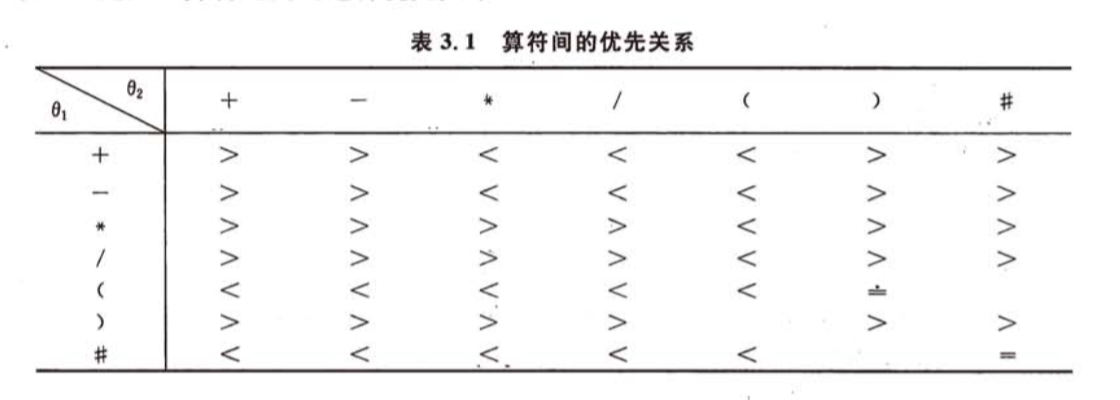数据结构 之 表达式求值
本文根据《数据结构》严蔚敏版中栈应用章节内容, 实现Java版表达式求值
其中为了简化起见,规定表达式合法, 且操作数为正整数, 操作符为+,-,*,/,(,), 辅助操作符#
import java.util.*;
/**
* 表达式计算, 简单起见, 规定表达式合法, 且操作数为正整数, 操作符为+,-,*,/,(,), 辅助操作符#
*/
public class Demo {
private static char[][] OPP = new char[127][127]; //Operator Priority
static {
// (op1, '+') = (op1,'-)
OPP['+']['+'] = OPP['+']['-'] = '>';
OPP['-']['+'] = OPP['-']['-'] = '>';
OPP['*']['+'] = OPP['*']['-'] = '>';
OPP['/']['+'] = OPP['/']['-'] = '>';
OPP['(']['+'] = OPP['(']['-'] = '<';
OPP[')']['+'] = OPP[')']['-'] = '>';
OPP['#']['+'] = OPP['#']['-'] = '<';
//(op1, '*) = (op1, '/);
OPP['+']['*'] = OPP['+']['/'] = '<';
OPP['-']['*'] = OPP['-']['/'] = '<';
OPP['*']['*'] = OPP['*']['/'] = '>';
OPP['/']['*'] = OPP['/']['/'] = '>';
OPP['(']['*'] = OPP['(']['/'] = '<';
OPP[')']['*'] = OPP[')']['/'] = '>';
OPP['#']['*'] = OPP['#']['/'] = '<';
//(op1, '(')
OPP['+']['('] = '<';
OPP['-']['('] = '<';
OPP['*']['('] = '<';
OPP['/']['('] = '<';
OPP['(']['('] = '<';
//OPP[')']['*']
OPP['#']['('] = '<';
//(op1, ')')
OPP['+'][')'] = '>';
OPP['-'][')'] = '>';
OPP['*'][')'] = '>';
OPP['/'][')'] = '>';
OPP['('][')'] = '=';
OPP[')'][')'] = '>';
//OPP['#']['('] = '<';
//(op1, '#')
OPP['+']['#'] = '>';
OPP['-']['#'] = '>';
OPP['*']['#'] = '>';
OPP['/']['#'] = '>';
//OPP['(']['#'] = '=';
OPP[')']['#'] = '>';
OPP['#']['#'] = '<';
}
public static char precede(char op1, char op2) {
return OPP[op1][op2];
}
public static int operate(int a, char op, int b) {
switch (op) {
case '+':
return a + b;
case '-':
return a - b;
case '*':
return a * b;
case '/':
return a / b;
}
return 0;
}
public static int EvaluateExpression(String expssion) {
if (expssion == null || expssion.length() == 0) return 0;
String expsWithEnd = expssion + "#";
char[] exps = expsWithEnd.toCharArray();
Stack<Character> OPTR = new Stack<>();
OPTR.push('#');
Stack<Integer> OPND = new Stack<>();
int k = 0;
char ch = exps[k++];
while(ch != '#' || OPTR.peek() != '#') {
if (Character.isDigit(ch)) {
int num = ch - '0';
while(k < exps.length && Character.isDigit(ch = exps[k])) {
num = num * 10 + (ch - '0');
k++;
}
OPND.push(num);
ch = exps[k++];
} else {
switch (precede(OPTR.peek(), ch)) {
case '<':
OPTR.push(ch);
ch = exps[k++];
break;
case '=':
//脱括号,接收下一个字符
OPTR.pop();
ch = exps[k++];
break;
case '>':
char op = OPTR.pop();
int b = OPND.pop();
int a = OPND.pop();
OPND.push(operate(a, op, b));
break;
}
}
}//while
return OPND.peek();
}
public static void main(String[] args) {
//String exp = "3*(7-2)";
String exp;
Scanner in = new Scanner(System.in);
while(in.hasNext()) {
exp = in.nextLine();
System.out.println(EvaluateExpression(exp));
}
}
}
/*
3*(7-2)
15
10*(12-2)
100
*/





